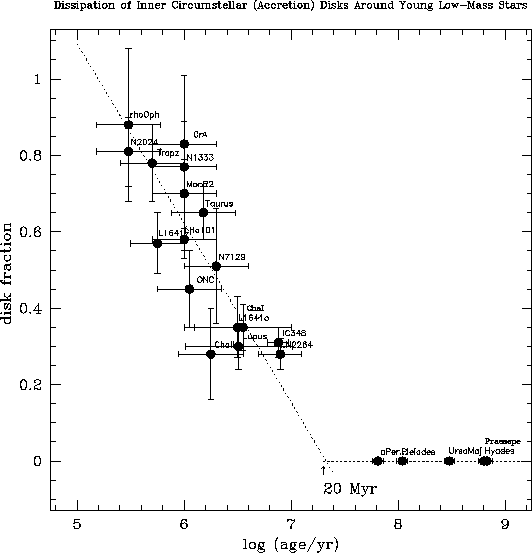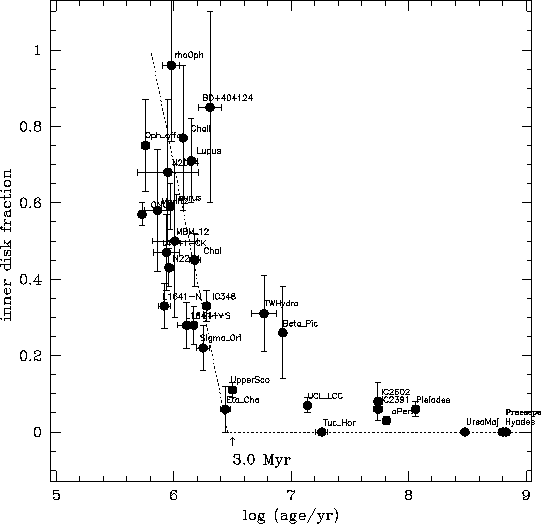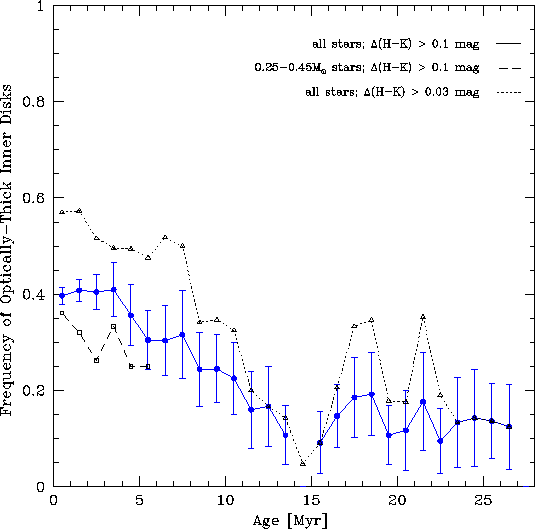
 [postscript version]
[postscript version]
 [postscript version]
[postscript version]
I have been interested for some time in constraining the evolutionary time scales for circumstellar dust disks. This is relevant to the buildup of stellar mass via accretion from disks, the determination of stellar angular momentum via star-disk locking, and planet formation processes. The figures in this section represent the extent of our ability to address the problem using currently available ground-based near-infrared data. In 2002 I wrote a small review paper on this topic, but that conference proceedings was never published, so in 2005 I wrote another one and as of 2007 it also never made it to press; both can be accessed here. Although this material deserves publication in a refereed journal given the enormous interest in the topic and lack of rigor in other treatments, I have become skeptical about stellar ages in the interim (note the 20 Myr vs 3 Myr dissipation time below) and have been working that problem first.

 [postscript version]
[postscript version]
 [postscript version]
[postscript version]
The figure on the left is a bit of a cheat since it relies on objects falling outside of reddening vectors in a (J-H) vs (H-K) diagram to identify them as disked objects, and uses "nominal" (i.e. not derived by me) ages for the clusters. Also, it is a bit outdated (circa 1995). I've had lots of requests for it so am making it available; but user beware!! The plot on the right is a 2003 version, which instead of using the (J-H) vs (H-K) diagram to identify objects with infrared excess, uses delta(H-K), the near-infrared color corrected for both extinction and the stellar photosphere. Ages are the mean ages of the cluster stars as inferred by me from the HR diagram. Note how different approaches to the same data can drastically change the conclusions! Also note that the ages of several clusters have "changed" between 1995 and 2003 due to more modern observations leading to rigorous analysis of their HR diagrams.
The figures below treat each star individually, instead of using the cluster medians. The down side of these versions is mainly in the age determinations, which give undue weight to stars which are erroneously scattered to older ages through observational and analysis errors.


An AAS poster paper on the evolutionary time scales for inner accretion disks can be found here and a less refined discussion here . Note that in all of the above plots, the near-infrared excess emission is diagnostic of hot inner (<0.1 AU) accretion disks. Objects without the signatures of active accretion onto the star may still possess optically thick passive disks or optically thin debris disks which do not produce measureable near-infrared excess. What is important for constraining planet formation is of course the evolution of disks in the mid-infrared, which is sensitive to dust located 1-5 AU away from the star. There is a decent summary of the same kind of thing as above but using mid-infrared photometry here. Quite a lot of us are looking towards SIRTF for the next big advance in this field.